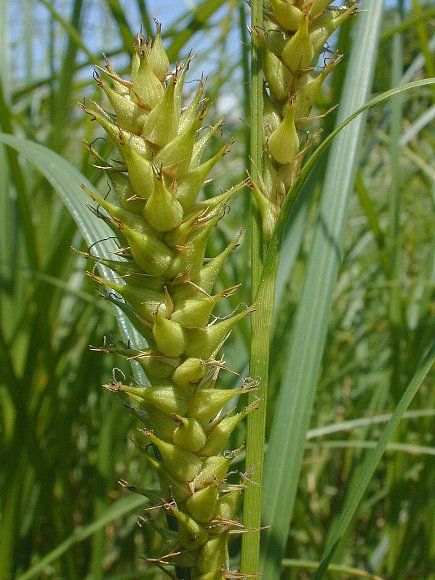Description: This perennial sedge is 2½–4' tall and more or less erect. Infertile shoots are more numerous and taller than fertile shoots. The culms are unbranched, sharply triangular in cross-section, light green, and glabrous. Each infertile shoot has about 7-8 alternate leaves, which are concentrated mostly toward the apex of the shoot. Each fertile shoot has about 2-3 alternate leaves underneath the inflorescence (excluding the leafy bracts). On infertile shoots, the leaf blades are up to 30" long and 8 mm. (1/3") across; they are medium green, channeled along the middle, glabrous, and rough to the touch on the upper surface and margins. On fertile shoots, the leaf blades are shorter (up to 18" long), otherwise they are the same as the blades on infertile shoots. The leaf blades are ascending or widely arching. The leaf sheaths are light to medium green, glabrous, and tight-fitting around their culms. Each sheath is concave and membranous at the apex of its inner side. The parallel veins of both the blades and sheaths are often nodulated at intervals and they are interconnected by small transverse veins.

The inflorescence of each fertile shoot is about 1-2' long and unbranched. It has 2-6 staminate spikelets and 2-4 pistillate spikelets. The staminate spikelets are elevated above the pistillate spikelets and widely separated from them. Each staminate spikelet is up to 5 cm. long, very slender, and straight; it soon turns dark brown after releasing its pollen. Each pistillate spikelet is about 5-7 cm. long, 1.5 cm. across, and light green while immature; it has a spiky-cylindrical appearance because of the numerous ascending perigynia along its length. Underneath each pistillate spikelet, there is a leafy bract up to 18" long that resembles the leaf blades. The lowest pistillate spikelet and uppermost staminate spikelet have short stiff pedicels, while the remaining spikelets are sessile or nearly so.

The perigynia are about 6-9 mm. long, 2.5–3.0 mm. across, and inflated; they are lanceoloid with long beaks and rounded bottoms. The outer surfaces of perigynia are longitudinally veined and finely pubescent (this may require magnification to see). The tip of each perigynium's beak has a pair of unusually long teeth about 1.5–2.0 mm. in length. The blooming period occurs during the summer, lasting about 1-2 weeks for a colony of plants. The florets are cross-pollinated by the wind. Afterwards, the pistillate spikelets become yellow and finally brown, when the individual perigynia disarticulate from their spikelets. Because these perigynia are inflated, they can be carried some distance by water. The achenes within these perigynia (one achene per perigynia) are about 2.0 mm. long, bluntly 3-angled, and oblanceoloid in shape. The root system is fibrous and rhizomatous. This sedge can produce sizable clonal colonies from its long rhizomes.

Cultivation:
The preference is full or partial sun, wet to moist conditions, and
fertile soil with abundant organic matter. This sedge can spread
aggressively.
Range & Habitat:
The native Hairy-Fruited Sedge is occasional in the northern half of
Illinois,
while in the southern half of the state it is rare or absent (see Distribution
Map). Habitats include soggy thickets, wet prairies, prairie
swales, fens,
sedge meadows, low-areas along streams, calcareous seeps, and
roadside ditches. This
sedge prefers fertile wetlands where there is seepage of mineral-rich
ground water or floodplains where nutrients are deposited from running
water. This helps to sustain the prodigious growth of this sedge.

Faunal Associations: Various insects feed on wetland sedges (Carex spp.). This includes sedge grasshoppers (Stethophyma spp.), semi-aquatic leaf beetles (Donacia spp., Plateumaris spp.), the Sedge Billbug (Sphenophorus costicollis), larvae of the shore fly Hydrellia griseola (Lesser Rice Leafminer), meadow katydids (Orchelimum spp.), seed bugs, plant bugs, Allaphis daviaulti and other aphids, leafhoppers (Cosmotettix spp.), and the Carex Mealybug (Trionymus caricis). Hairy-Fruited Sedge (Carex trichocarpa) is the preferred host plant for the caterpillars of Euphyes bimacula (Two-spotted Skipper). The caterpillars of a butterfly, Satyrodes eurydice (Eyed Brown), feed on wetland sedges, as do the larvae of such moths as Hypocoenia inquinata (Tufted Sedge Moth) and Amphipoea americana (American Ear Moth). See the Insect Table for a more complete listing of these species. Waterfowl, rails, and some granivorous songbirds eat the seeds or spikelets of wetland sedges (see the Bird Table). Because Hairy-Fruited Sedge is tall-growing and forms dense colonies, it provides good cover for various wetland animals, including ducks, rails, snakes, frogs, small rodents, and invertebrates. This sedge also provides habitat and material for bird nests.

Photographic
Location:
A low meadow along a railroad in Champaign, Illinois.
Comments:
Hairy-Fruited Sedge (Carex
trichocarpa) is one of the larger and more attractive
sedges in
Illinois. It is a member of a small group of tall wetland sedges that
have multiple staminate and pistillate spikelets per culm. Perhaps the
best-known member of this group is Lake Sedge (Carex lacustris).
Hairy-Fruited Sedge differs from other sedges in this
group primarily by its pubescent perigynia and the long teeth at the
tips of its perigynial beaks. It also has more narrow leaf blades than
Lake Sedge and some other sedges from this group. Unlike another
wetland sedge, Tussock Sedge (Carex
stricta), Hairy-Fruited Sedge does not form
dense clumps of stalks and leaves above an elevated root mass. Instead,
individual shoots develop from the long rhizomes to form a more even
sod within a colony of plants. This is one of the few sedges that can
compete with Reed Canary Grass (Phalaris arundinacea)
in wetland habitats.